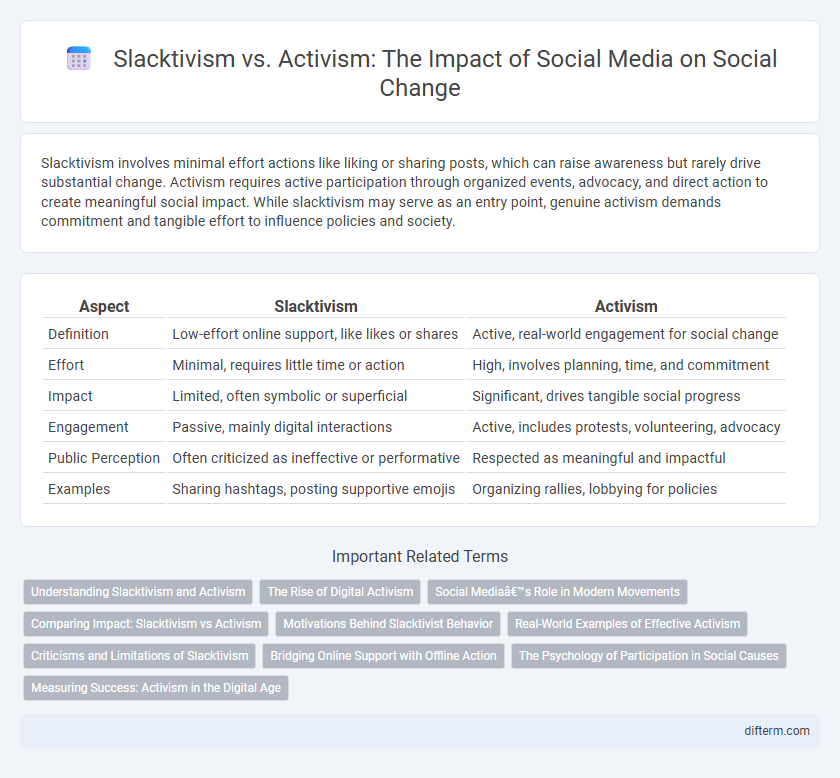Slacktivism involves minimal effort actions like liking or sharing posts, which can raise awareness but rarely drive substantial change. Activism requires active participation through organized events, advocacy, and direct action to create meaningful social impact. While slacktivism may serve as an entry point, genuine activism demands commitment and tangible effort to influence policies and society.
Table of Comparison
| Aspect | Slacktivism | Activism |
|---|---|---|
| Definition | Low-effort online support, like likes or shares | Active, real-world engagement for social change |
| Effort | Minimal, requires little time or action | High, involves planning, time, and commitment |
| Impact | Limited, often symbolic or superficial | Significant, drives tangible social progress |
| Engagement | Passive, mainly digital interactions | Active, includes protests, volunteering, advocacy |
| Public Perception | Often criticized as ineffective or performative | Respected as meaningful and impactful |
| Examples | Sharing hashtags, posting supportive emojis | Organizing rallies, lobbying for policies |
Understanding Slacktivism and Activism
Slacktivism involves low-effort online actions like sharing posts or signing digital petitions that give a sense of contribution without significant impact, whereas activism requires direct engagement and sustained efforts to drive social or political change. Understanding slacktivism helps distinguish between symbolic participation and meaningful activism that mobilizes resources and influences policy. Recognizing the limitations of slacktivism highlights the importance of combining online awareness with real-world actions to achieve tangible outcomes.
The Rise of Digital Activism
The rise of digital activism has transformed traditional forms of social engagement by enabling instant online campaigns and widespread awareness through platforms like Twitter and Facebook. While slacktivism offers low-effort ways for individuals to express support, true activism involves sustained commitment and offline actions that foster tangible change. Digital tools bridge global communities, yet the impact depends on converting online participation into real-world advocacy and policy influence.
Social Media’s Role in Modern Movements
Social media platforms amplify slacktivism by allowing users to engage in low-effort actions like sharing posts or changing profile pictures, which often lack tangible impact on social change. In contrast, activism leverages these platforms to organize real-world events, mobilize supporters, and spread in-depth information that fuels sustained movements. The digital ecosystem's reach and immediacy make social media a critical battleground where slacktivism and genuine activism continuously intersect and evolve.
Comparing Impact: Slacktivism vs Activism
Slacktivism often generates minimal real-world change by limiting engagement to low-effort online actions such as liking or sharing posts, which rarely translate into concrete policy shifts or social improvement. In contrast, activism drives substantial impact through sustained efforts including organizing protests, lobbying lawmakers, and community mobilization that foster tangible socio-political transformations. While slacktivism raises awareness quickly, activism's depth and commitment are critical for achieving measurable and lasting societal progress.
Motivations Behind Slacktivist Behavior
Slacktivist behavior often stems from a desire for social validation and the ease of digital engagement without significant personal sacrifice. Motivations include low effort involvement, such as liking or sharing posts, which provides a sense of contribution without requiring direct action. This contrasts with activism, where individuals are driven by deeper commitment and willingness to undertake tangible efforts for social change.
Real-World Examples of Effective Activism
Real-world examples of effective activism include the 2010 Ice Bucket Challenge, which raised over $115 million for ALS research through active participation and donations rather than passive online engagement. The Black Lives Matter movement demonstrated sustained, organized protests and policy advocacy that led to tangible changes in police reform and public awareness. These cases illustrate that meaningful activism combines online awareness with offline action to drive social change.
Criticisms and Limitations of Slacktivism
Slacktivism is often criticized for promoting low-effort online actions that create an illusion of impact without driving substantial social change. Critics argue that slacktivism can divert energy from more effective, real-world activism by reducing individuals' motivation to engage in meaningful, sustained efforts. The limitations include limited awareness beyond social media circles and the risk of superficial engagement that fails to challenge systemic issues.
Bridging Online Support with Offline Action
Slacktivism often involves minimal online engagement that lacks tangible impact, whereas true activism bridges digital support with concrete offline actions such as protests, community organizing, and policy advocacy. Effective movements harness the power of social media campaigns to mobilize physical participation, transforming virtual solidarity into measurable social change. Integrating online awareness with grassroots efforts amplifies influence, ensuring that digital activism drives real-world outcomes.
The Psychology of Participation in Social Causes
Slacktivism often appeals to the desire for easy, low-effort participation, satisfying psychological needs for social approval without deep engagement. Genuine activism stimulates intrinsic motivation through commitment, identity reinforcement, and the pursuit of meaningful change, activating stronger emotional and cognitive involvement. Understanding these psychological drivers clarifies why meaningful participation requires more than symbolic actions to effect real social change.
Measuring Success: Activism in the Digital Age
Measuring success in activism today involves analyzing tangible outcomes like policy changes, community engagement, and sustained social impact rather than mere digital impressions or online shares associated with slacktivism. Digital activism platforms such as Change.org and Avaaz provide metrics on petition signatures and social reach, but these numbers often lack the depth required to evaluate long-term effectiveness. Advanced analytics tools and sentiment analysis on social media help activists gauge genuine public support and mobilization beyond surface-level participation, offering a clearer picture of campaign success in the digital age.
slacktivism vs activism Infographic

 difterm.com
difterm.com